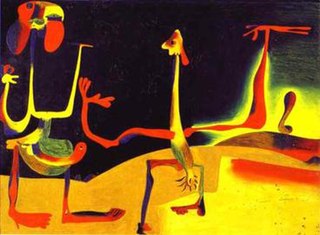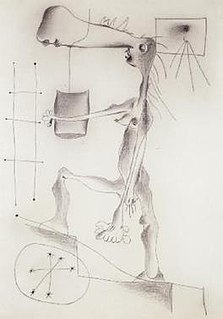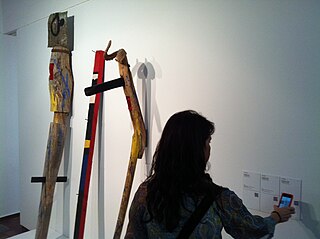
The Fundació Joan Miró, Centre d'Estudis d'Art Contemporani is a museum of modern art honoring Joan Miró located on the hill called Montjuïc in Barcelona, Catalonia (Spain).
Banco Português de Negócios, or simply BPN, was a Portuguese banking institution. It used to be a private bank, but was nationalized by the Portuguese Government in 2008 after a bad management and malpractice-related debt of 1.800 billion euros and several irregularities uncovered in the institution. In 2012, BPN, stripped of many of its debts and bad loans, was sold to Angola’s Banco BIC for €40 million.

Gallifa is a municipality in the comarca of the Vallès Occidental in Catalonia, north-eastern Spain. It contains the Castle of Gallifa and was the location of the studio of ceramic artist Josep Llorens i Artigas and his son.

Man and Woman in Front of a Pile of Excrement is a 1935 oil painting on copper by Joan Miró.

Portrait of Vincent Nubiola is an oil painting by Spanish artist Joan Miró. Painted in 1917 when Miró was 24 years old, a year before his first exhibition, the portrait is now considered a masterpiece from a period when he experimented with both Cubism and Fauvism. It is also said by some art critics to show the influence of Van Gogh. Acquired for a time by Picasso, the painting is now in the permanent collection of the Folkwang Museum in Essen (Germany).
Paintings on masonite is a series of 27 abstract paintings made by Joan Miró using the type of proprietary hardboard known as masonite, just after the Spanish Civil War started on 18 July 1936. These works break with his earlier phase which was known as his wild paintings period. This was a label established to describe the work done during the two years preceding the Civil War, between 1934 and 1936.

Naked Woman Climbing a Staircase is a drawing done with pencil and charcoal on card made by Joan Miró in 1937. It is part of the permanent collection of the Fundació Joan Miró in Barcelona.

Hands flying off toward the constellations is a painting by Joan Miró dated 19 January 1974. It is now shown at the Fundació Joan Miró, in Barcelona. The artist gave the work to the Foundation in the same month that it opened to the public on 10 June 1975.

The navigator's hope is a series of paintings made by Joan Miró between 1968 and 1973, half of which now belong to the permanent collection of the Fundació Joan Miró in Barcelona, thanks to a donation by Pilar Juncosa. The rest of the series are preserved in various private collections.

Her Majesty the Queen is an object-sculpture made by Joan Miró in 1974 and now part of the permanent collection of the Joan Miró Foundation in Barcelona.

His Highness the Prince is an object-sculpture made by Joan Miró in 1974 and now part of the permanent collection of the Joan Miró Foundation in Barcelona.
The Hope of a Condemned Man is a series of three paintings by Joan Miró in 1974 which are now part of the permanent collection of the Joan Miró Foundation in Barcelona.

Still Life with Old Shoe is a 1937 oil painting by Joan Miró, now part of the permanent collection of the Museum of Modern Art in New York City. The work was given to the museum by James Thrall Soby in 1970.
Miró otro, originally spelled backwards as Orim, was a retrospective of the Catalan painter Joan Miró's work organized by Official College of Architects of Catalonia (COAC) at its headquarters in Barcelona during April–June 1969. One of the most important and transgressors of this exhibit was the art intervention made by the artist and collaborators before the opening of the exhibition, and destroyed by him and collaborators later.
The Reaper, also known as Catalan peasant in revolt was a large mural created by Joan Miró in Paris in 1937 for the Spanish Republic’s pavilion at the Paris International Exhibition that year. It was one of his largest works, 5.5 metres (18 ft) high, but was destroyed or lost in 1938. Only a few black and white photographs survive.
Painting is a 1927 painting by the Catalan artist Joan Miró. In June 2012, it sold at auction for £23.5 million, setting a new record for the highest price paid for a painting by Miró.

The World Trade Center Tapestry was a large tapestry by Joan Miró and Josep Royo. It was displayed in the lobby of 2 World Trade Center in New York City from 1974 until it was destroyed in 2001 by the collapse of the World Trade Center.

The Wall of the Sun and Wall of the Moon are a pair of murals made of ceramics and designed by the Catalan artist Joan Miró for the UNESCO building in Paris. The works were carried out by the ceramicist Josep Llorens Artigas in 1955. Initially, the walls were installed on the Place de Fontenoy in Paris, but afterwards were enclosed in a building that was constructed in order to protect them from damage caused by acid rain.
Josep Llorens i Artigas was a Spanish ceramic artist known for his collaboration with Joan Miró. He is credited with relaunching ceramics as a European art form.













